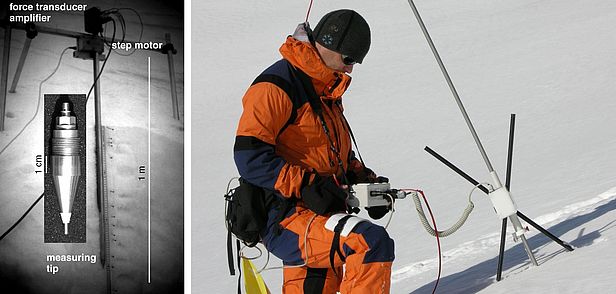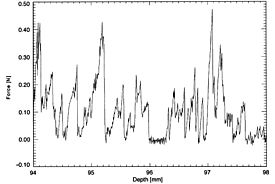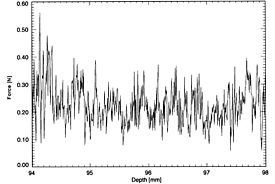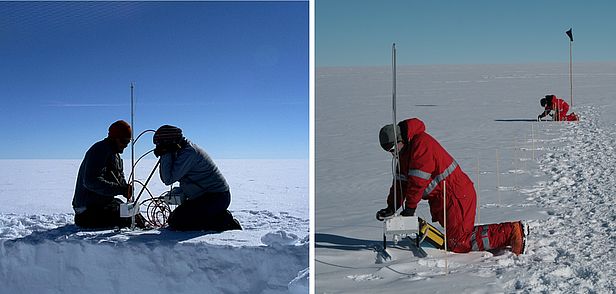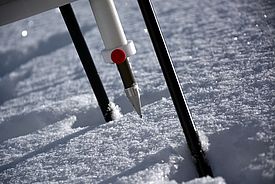
SnowMicroPen® ¶
The SnowMicroPen (SMP for short) measures the penetration resistance of snow. We and many others use it to measure snowprofiles more precisely, better understand avalanche formation, polar snow formation and radar measurements. Even after years of development, we still find details to improve. This is a portrait of an "instrument in progress".
An important goal of the first generation of snow researchers at SLF was to measure snow mechanical properties quickly. The then developed ramsonde is used until today.
The ramsonde measures the position of harder and softer snow layer in a snow pack without the need to dig a snowprofile. However, already the first measurements showed that only a relatively coarse stratigraphy could be measured, with a bias for harder layers. Dowd and Brown (1986) developed in the 1980'ies a digital resistograph, a penetrometer to measure the penetration resistance continously. However, this instrument also had a cone tip that was too large to resolve the important thin weak layers in a snowpack. Schneebeli and Johnson (1998) started to develop in the mid 1990'ies a new penetrometer, which they called "SnowMicroPen". The SMP has a very large force range and is sensitive to minute changes in penetration resistance, and the advantage to be fast.
The penetration resistance depends on the strength of bonded snowstructure. Although the first SMP (Fig. 1) measured at the vertical resolution of 0.3 mm, thin layers of 2 mm thickness could be detected for the first time.
A surprising observation was made in 1997 by Schneebeli and Johnson in a joint experiment at CRREL Alaska. They decreased the sampling distance to 0.05 mm, as they were curious if they could see a structural signal. In fact, they observed that the force signal of each snow type had a characteristic shape. This was the first step towards an objective characterisation of the snow microstructure with the SMP. The latest development of the theory (Löwe and Van Herwijnen, 2011) can be used to interpret micro-mechanical and micro-structural properties.
The use of the SMP in avalanche formation research
Two major aspects relevant to snow avalanche formation can be measured with the SMP: we can measure weak layers and their spatial variability. The propagation of a fracture in the snowpack depends not the least from the spatial homogeneity of the weak layer. The project "Spatial variability" is devoted to the investigation of the variability of the snowpack in avalanche prone slopes. The measurements were used in several projects and PhD-theses, e.g. C. Pielmeier (2003), K. Kronholm (2004), S. Bellaire (2010) and E. Lutz (2009). Finally, the SMP is the only instrument that measures at a speed that the mechanical variability of the snowpack can be convincingly mapped.
Another challenge is to extract a simplified stratigraphy out of the complex signal. Several algorithms were developed to detect weak layers, and they have a comparable success rate in defining instability as direct mechanical tests (Pielmeier and Marshall, 2009).
Nevertheless, our knowledge about the stratigraphy of weak layers is still incomplete. In a complementary project (microstructure of weak layers) we cast samples of weak snow layers, and investigate their properties by computer tomography.
The SMP in polar regions
The development of an instrument that resists the extreme weather and temperature conditions in polar regions, and measures at the same time force of one hundredths of a Newton and up to 70 Newton, is a challenge. The SMP has successfully proven in several polar expeditions, and shows it strengths in measuring the snow and firn stratigraphy. Examples of expeditions are the SnowStar2002-traverse (Sturm et al., 2004), in Greenland on the Summit (Fig. 3), during the EXPLORE-traverse between Vostok and Concordia station, and at Kohnen station. The stratigraphy at Kohnen station could be quantified by several hundred measurements.
The SMP and microwave measurements ¶
Radar and microwave radiometers are increasingly used to investigate the snowpack. Both methods are sensitive to the layering within the snowpack. In case of the microwaves, the layering is required to calculate the emitted microwave radiation and its relation to the snow water equivalent. For the radar, the return signal the retrieval of the snow density of the layers requires additional information about the depth of these layers. Marshall et al. (2007) used a SMP to add this information. However, still much is to learn about the interactions between snow and microwaves. In preparation of the satellite mission CoReH2O, the Nordic Snow Radar Experiment (NoSREx) was conducted. The correlation length of the snow microstructure was measured in field measurement campaigns using the SMP, applying a new statistical model derived from the SMP-force signal.
The SMP and the snow structure ¶
In the best case we would calculate the microstructural properties of the snowpack directly from the mechanically generated force signal. However, we are not yet completely advanced to this point. Since the begin of the development of the SMP, several researchers could improve our understanding of this process (Johnson and Schneebeli 1999, Marshall and Johnson 2009, Löwe and van Herwijnen 2012, Proksch et al. 2015). We currently work on the statistical theory using concepts from statistical physics.
The contact and mechanical deformation at the tip of the cone and snow is simulated using discrete elements. The movie shows the penetration of an SMP-tip in a largely simplified sintered material, with similar mechanical properties as snow has. Our next goal is to come closer to a more realistic structural representation and a to implement improved ice-mechanical properties.
(Kopie 6) ¶
Publications ¶
Bellaire, S. 2010. Spatial variability of the snow cover and its effect on avalanche formation. Ph.D. thesis, University of Hamburg.
Dowd, T., and R. Brown (1986), A new instrument for determining strength in snow cover, Journal of Glaciology, 32(111), 299–301.
Kronholm, K. 2004. Spatial variability of snow mechanical properties with regard to avalanche formation. Ph.D. thesis, Department of Geography, University of Zurich. 187 pp.
Lutz, E.L. 2009. Spatial and temporal analysis of snowpack strength and stability and environmental determinants on an inclined, forest opening. Ph.D. Dissertation, Department of Earth Sciences, Montana State University. 364 pp.
Pielmeier, C., 2003. Textural and mechanical variability of mountain snowpacks. PhD thesis, University of Berne, 127 pp.
Sturm, M., J. Johnson, and J. Holmgren (2004), Variations in the mechanical properties of arctic and subarctic snow at local (1-m) to regional (100-km) scales, in Proceedings of the International Symposium on Snow Monitoring and Avalanches (ISSMA-2004), Manali, India, pp. 233–238.
